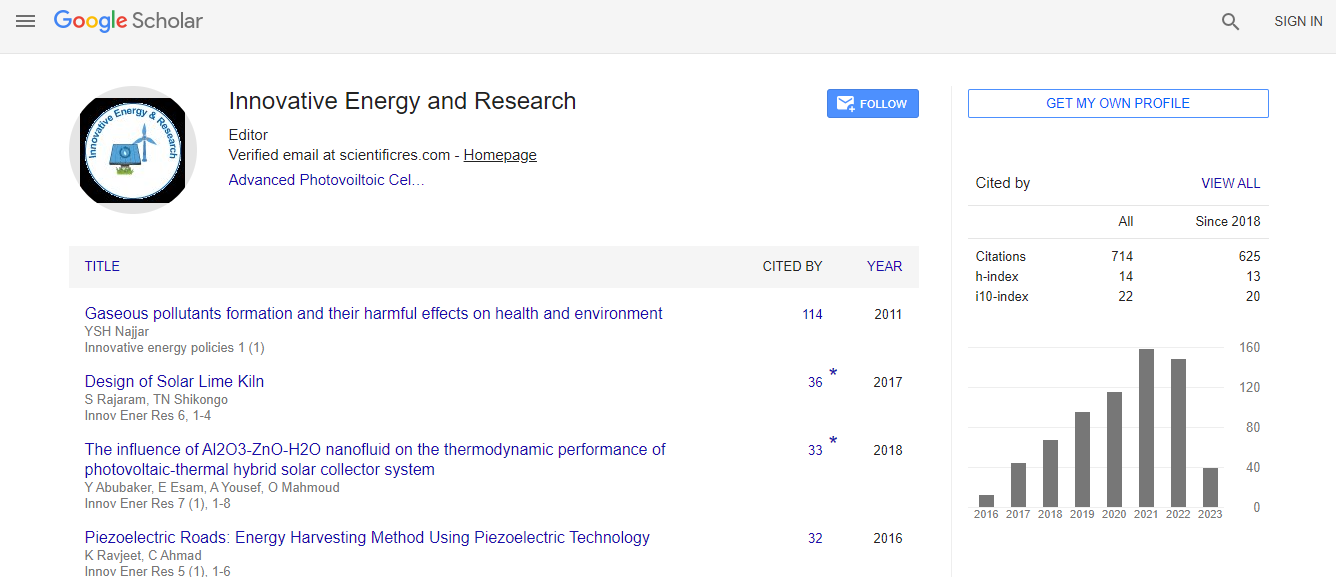Our Group organises 3000+ Global Conferenceseries Events every year across USA, Europe & Asia with support from 1000 more scientific Societies and Publishes 700+ Open Access Journals which contains over 50000 eminent personalities, reputed scientists as editorial board members.
Open Access Journals gaining more Readers and Citations
700 Journals and 15,000,000 Readers Each Journal is getting 25,000+ Readers
Google Scholar citation report
Citations : 712
Innovative Energy & Research received 712 citations as per Google Scholar report
Innovative Energy & Research peer review process verified at publons
Indexed In
- Google Scholar
- Open J Gate
- Genamics JournalSeek
- RefSeek
- Hamdard University
- EBSCO A-Z
- Publons
- Euro Pub
- ICMJE
Useful Links
Recommended Journals
Related Subjects
Share This Page
Semiconductor nanostructure engineering for solar hydrogen production
21st International Conference on Advanced Energy Materials and Research
Sabiha Akter Monny, Zhiliang Wang and Lianzhou Wang
The University of Queensland, Australia
ScientificTracks Abstracts: Innov Ener Res
Abstract
Photoelecctrochemcial water splitting provides an attractive method to convert the abundant solar energy into sustainable and clean hydrogen energy. The greatest challenge is how to develop efficient and stable photoelectrodes, including photoanodes and photocathodes. Comparing to the widely studied photoanodes, the photocathodes have been paid less attention due to the scarcity of suitable semiconductor candidates. Some available photocathodes derived from p-type semiconductors such as single crystal Si, chalcogenide (e.g., CuInGaSe) are either not stable or too expensive to realize large scale application. Herein, a promising p-type semiconductor, CuBi2O4, has been used to fabricate efficient photocathode. Moreover, combining the CuBi2O4 photocathode with well-developed BiVO4 photoanode, it is able to demonstrate unbiased sunlight-driven solar water splitting. CuBi2O4 electrodes were prepared with electrodeposited BiOI and copper acetylacetonate as precusor after heating in air at 450°C for 4 hours. The CuBi2O4 photocathode possesses a porous nano branch strucutre and showed a photocurrent of -0.95 mA/cm2 at 0.21 VRHE along with an onset potential at 1.1 VRHE in Sodium Phosphate (~pH 7) electrolyte. With the presence of electron scavengers, the photocurrent was further enhanced to -2.4 mA/cm2 at 0.48 VRHE. The incident photon-to-current efficiency showed a threshold at ca. 620 nm, suggesting a broad light harvesting range of the CuBi2O4 photocathode. Furthermore, the large onset potential of CuBi2O4 photocathode makes it feasible to realize unbiased photoelectrode water splitting when combined with suitable photoanode, such as BiVO4.Biography
Sabiha Akter Monny is a PhD student at the University of Queensland. She specialises in renewable energy, energy conversion and nanomaterials. Her research focuses on developing photocatalysts using semiconductor nanomaterials for photoelectrochemical energy conversion.
E-mail: s.monny@uq.edu.au

 Spanish
Spanish  Chinese
Chinese  Russian
Russian  German
German  French
French  Japanese
Japanese  Portuguese
Portuguese  Hindi
Hindi 
